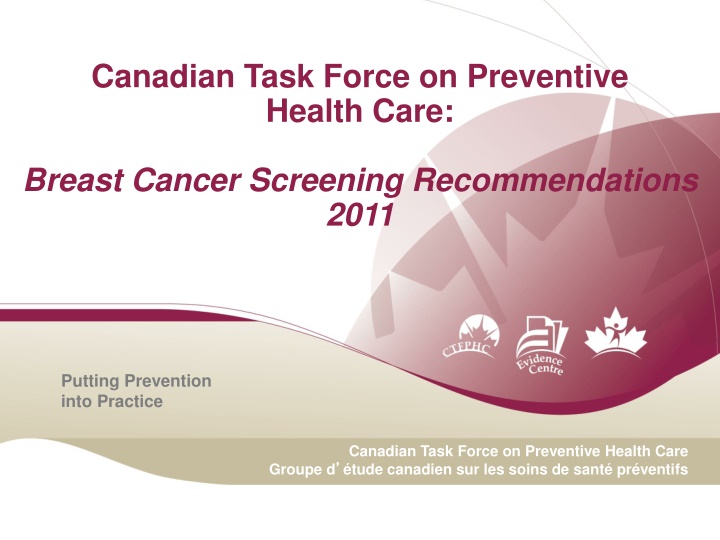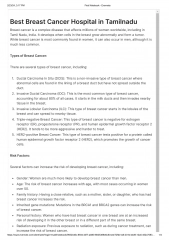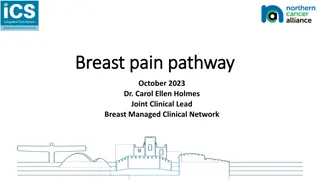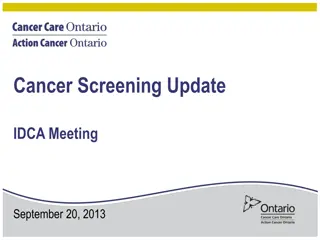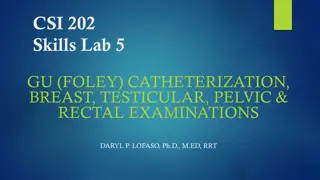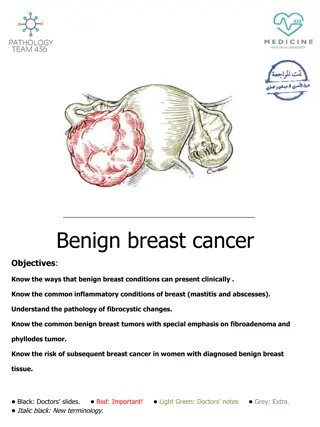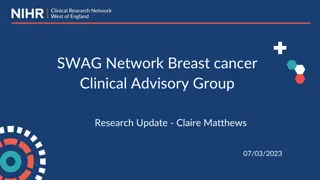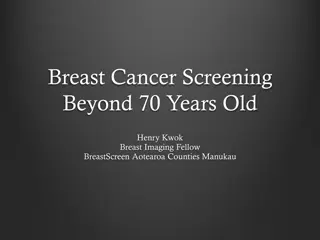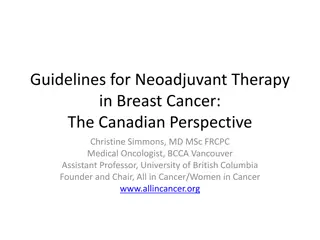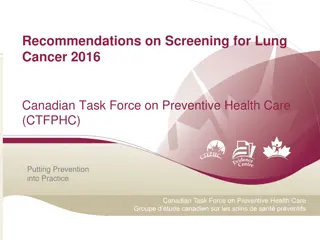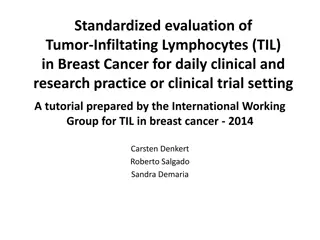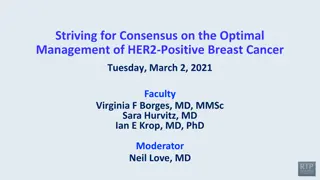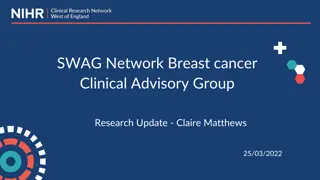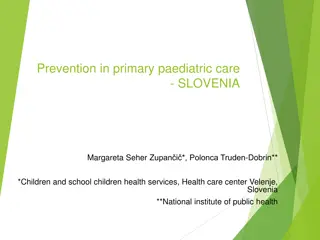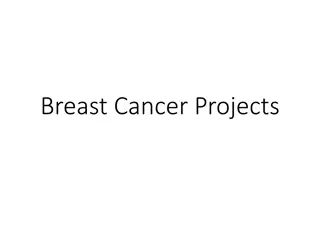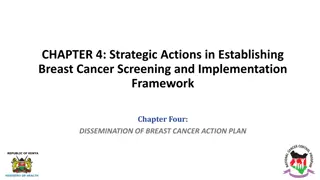Canadian Task Force on Preventive Health Care: Breast Cancer Screening Recommendations 2011
Breast cancer screening recommendations by the Canadian Task Force on Preventive Health Care focus on the importance of regular screenings such as clinical breast exams, self-exams, and mammography to reduce mortality rates. The Task Force consists of primary care experts aiming to develop guidelines supporting preventive health care delivery. While early detection through screening is beneficial, potential harms like anxiety, unnecessary tests, and overdiagnosis should be considered.
Download Presentation

Please find below an Image/Link to download the presentation.
The content on the website is provided AS IS for your information and personal use only. It may not be sold, licensed, or shared on other websites without obtaining consent from the author.If you encounter any issues during the download, it is possible that the publisher has removed the file from their server.
You are allowed to download the files provided on this website for personal or commercial use, subject to the condition that they are used lawfully. All files are the property of their respective owners.
The content on the website is provided AS IS for your information and personal use only. It may not be sold, licensed, or shared on other websites without obtaining consent from the author.
E N D
Presentation Transcript
Canadian Task Force on Preventive Health Care: Breast Cancer Screening Recommendations 2011 Putting Prevention into Practice Canadian Task Force on Preventive Health Care Groupe d tude canadien sur les soins de sant pr ventifs
Overview CTFPHC Background Breast Cancer: Overview Scientific Methods Breast Cancer Screening Recommendations Details of Recommendations Questions & Answers Canadian Task Force on Preventive Health Care 2
Who is the CTFPHC? The Canadian Task Force on Preventive Health Care (CTFPHC) Comprised of 14 primary care experts Established to develop clinical practice guidelines that support primary care providers in delivering preventive health care Identify evidence gaps that need to be filled and develop guidance documents for each topic Canadian Task Force on Preventive Health Care 4
BREAST CANCER: OVERVIEW
Breast Cancer Overview Regular screening for breast cancer with clinical breast exam, breast self exam, and mammography is widely recommended to reduce breast cancer mortality There has been interest in magnetic resonance imaging for screening, although this is not widely used although screening has the potential to help women by early detection of treatable cancer, it also has potential harms: anxiety unnecessary tests and treatments overdiagnosis Canadian Task Force on Preventive Health Care 6
Methods of the CTFPHC Working group: 2 5 CTFPHC members Evidence Review and Synthesis Centre (ERSC) Working group Review analytical framework, develop protocol, summarize evidence Research questions and analytical framework Develop recommendations by consensus Canadian Task Force on Preventive Health Care 8
Eligible Studies for Clinical Practice Guidelines Women aged 40 and older, without pre-existing breast cancer and not considered to be at high risk for breast cancer Study Designs Effectiveness of screening: RCTs or meta-analyses Cost-effectiveness of screening: Included if relevant to KQ Harms of screening: Various designs and multiple data sources Patient preferences and values: Any study design Canadian Task Force on Preventive Health Care 9
GRADE: How is evidence graded? Quality of Evidence Explanation There is high confidence that the true effect lies close to the estimate of the effect High The true effect is likely to be close to the estimate of the effect, but there is a possibility that it is substantially different Moderate The true effect may be substantially different from the estimate of the effect Low Any estimate of effect is very uncertain Very Low Canadian Task Force on Preventive Health Care 10
GRADE: How is the strength of recommendations graded? Recommendations graded as strong or weak Strength of recommendations is based on 4 factors: o Balance between desirable and undesirable effects o Certainty of effects o Values and preferences o Feasibility and resource implications Equally important Canadian Task Force on Preventive Health Care 11
GRADE: Interpretation of Recommendations Implications Strong Recommendation Weak Recommendation For Primary Care Providers Most individuals should receive the intervention. Recognize that different choices will be appropriate for individual patients; clinicians must help patients make management decisions consistent with values and preferences. The majority of individuals in this situation would want the suggested course of action but many would not. For Patients Most individuals would want the recommended course of action; only a small proportion would not. Canadian Task Force on Preventive Health Care 12
BREAST CANCER SCREENING RECOMMENDATIONS: CBE, BSE and MRI
CTFPHC Recommendation: Clinical Breast Exam (CBE) We recommend not routinely performing CBE alone or in conjunction with mammography to screen for breast cancer. (Weak recommendation; low quality evidence) Canadian Task Force on Preventive Health Care 14
Effectiveness & Harm: Clinical Breast Exam (CBE) Effectiveness of CBE has not been established Harm of CBE: o For each additional cancer detected with CBE per 10,000 women, there would be an additional 55 false-positives (Chiarelli et al, 2009) Canadian Task Force on Preventive Health Care 15
CTFPHC Recommendation: Breast Self Exam (BSE) We recommend not advising women to routinely practice BSE (Weak recommendation; moderate quality evidence) Canadian Task Force on Preventive Health Care 16
Effectiveness: Breast Self Exam (BSE) Outcomes Illustrative Comparative Risks* (95% CI) Assumed Risk per million Relative Effect (95% CI) No of Quality of the Evidence (GRADE) Participants (Studies) Corresponding Risk per million (range) Control BSE Breast Cancer Mortality 1,540 1,509 (1,278 to 1,771) RR 0.98 (0.83 to 1.15) 387,359 (2 studies) Moderate1,2,3 Follow-up: mean 5 years *The basis for the assumed risk (e.g. the median control group risk across studies) is provided in footnotes. The corresponding risk (and its 95% confidence interval) is based on the assumed risk in the comparison group and the relative effect of the intervention (and its 95% CI). 1 blinding and concealment were not clear 2 no heterogeneity exists. P-value for testing heterogeneity is 0.561 and I2=0%. 3 the question addressed is the same for the evidence regarding the population, comparator and outcome. Canadian Task Force on Preventive Health Care 17
Harm: Breast Self Exam (BSE) Two moderate quality RCTs show that BSE increases the incidence of having a breast biopsy that shows no evidence of cancer. Russia trial: Shanghai trial: RR 2.05 95% Cl 1.80 2.33 RR 1.57 95% Cl 1.48 1.68
CTFPHC Recommendation: Magnetic Resonance Imaging (MRI) We recommend not routinely screening with MRI (Weak recommendation; no evidence) Canadian Task Force on Preventive Health Care 19
BREAST CANCER SCREENING RECOMMENDATIONS: MAMMOGRAPHY
Recommendation Criteria Apply only to women aged 40 74 Do not apply towomen at higher risk of breast cancer o Personal history, or history in first degree relative o Known BRCA1/BRCA2 mutation o Prior chest wall radiation No recommendations for women aged 75 and older due to lack of data Canadian Task Force on Preventive Health Care 21
CTFPHC Recommendation: Mammography (40-49 years) For women aged 40 49 years we recommend not routinely screening with mammography (Weak recommendation; moderate quality evidence) Canadian Task Force on Preventive Health Care 22
Findings and Implications: 40-49 years Significant reduction in RR Absolute benefit lower than for older women CTFPHC judgment: Most women should not receive screening but many could receive it o Less favourable balance of benefit vs. harm, compared to older women o Risk of FP higher, compared to older women o Clinicians must consider patient preferences and values Canadian Task Force on Preventive Health Care 23
CTFPHC Recommendation: Mammography (50-69 years) For women aged 50 69 years we recommend routinely screening with mammography every 2 to 3 years (Weak recommendation; moderate quality evidence) Canadian Task Force on Preventive Health Care 24
Findings and Implications: 50-69 years Mammography: significant reduction in relative risk Absolute benefit of screening remains small CTFPHC judgment: Most women of this age should receive screening but many should not o Mammography is associated with both harms and benefits o Clinicians should consider patient preferences and values Canadian Task Force on Preventive Health Care 25
CTFPHC Recommendation: Mammography (70-74 years) For women aged 70 74 years we recommend routinely screening with mammography every 2 to 3 years (Weak recommendation; low quality evidence) Canadian Task Force on Preventive Health Care 26
Findings and Implications: 70-74 years Point estimate for RR similar to younger women; borderline significant Absolute benefit similar or more favourable than for 50- 69 years CTFPHC judgment: Most women of this age should receive screening but many should not o Mammography is associated with both harms and benefits o Clinicians should consider patient preferences and values Canadian Task Force on Preventive Health Care 27
Estimates of Adverse Outcomes To save one life from breast cancer over 11 years Screening every 2 3 years Unnecessary breast biopsy False positive mammogram Women aged 40 49 years 2100 women 75 women 690 women Women aged 50 69 years 720 women 26 women 204 women Women aged 70 74 years 450 women 11 women 96 women Canadian Task Force on Preventive Health Care 28
Frequency of Screening CTFPHC suggests a screening interval of 2 3 years for women aged 50 74 years Data from sole RT comparing screening intervals suggested no significant difference between 1 and 3 years. Pooled analysis suggest mortality with >24 month screening is similar to < 24 month screening. Screening interval of 2 3 years preserves benefit of annual screening, reduces AE s, inconvenience and cost.
Frequency of Screening: RCT shows no difference between q1y and q3y screening Women aged 50 62 years Study arm (n=37,530): 3 additional annual screens Control arm (n=38,492): standard screen 3 years later Predicted RR of breast cancer mortality for annual vs. 3- year screening: 0.95 (95% CI, 0.83-1.07) by NPI 0.89 (95% CI, 0.77-1.03) by 2CS Actual RR of breast cancer mortality in follow-up: 0.93 (0.63, 1.37) UKCCCR Group, Eur J Cancer 2002; Duffy et al (Abstract) 2008 Canadian Task Force on Preventive Health Care 30
Patient Preferences and Values Most women value reduction in risk of breast cancer mortality Consider: Psychological distress following false positive Most women willing to take risk of false positive/unnecessary procedures in exchange for reduced risk of death BUT many are not The extent to which women participating in preference studies were informed of true risks and benefits is unclear Canadian Task Force on Preventive Health Care 31
Comparison of Guidelines Mammography Breast Self Exam Clinical Breast Exam Organization 40 49 years Recommend against routine screening. Individual decision. 50 74 years 75 + years No recommendation Recommend against Recommend against Every 2-3 years CTFPHC (2011) Every 1-2 years (age 50 69) (1998) No recommendation (1994) Recommend against (age 40 69) (2001) Every 1 2 years (age 50 69) (1998) No recommendation (2001) Previous CTFPHC (1994; 1998; 2001) Recommend against routine screening. Individual decision. Mammography every 2 years Insufficient evidence Recommend against Insufficient evidence USPSTF (2009) USA Every 2 years (age 50 69) No active recruitment BreastScreen Australia No active recruitment N/A N/A NHS screening program, United Kingdom No active recruitment* Recruited every 3 years until age 70 Women over 70 not routinely recruited* Not recommended Not recommended * The National Health Service (NHS) is phasing in an extension to their breast cancer screening program that will extend screening Mammography every three years to women aged 47-73 years Canadian Task Force on Preventive Health Care 32
Summary: Mammography For women aged 40 49 years we recommend not routinely screening with mammography (Weak recommendation; moderate quality evidence) For women aged 50 69 years we recommend routinely screening with mammography every 2 to 3 years (Weak recommendation; moderate quality evidence) For women aged 70 74 years we recommend routinely screening with mammography every 2 to 3 years (Weak recommendation; low quality evidence) Canadian Task Force on Preventive Health Care 33
